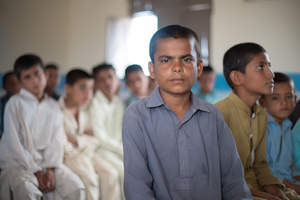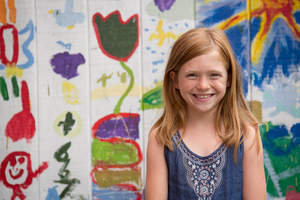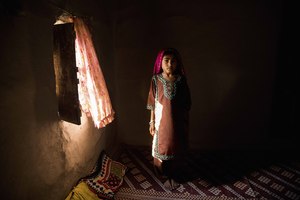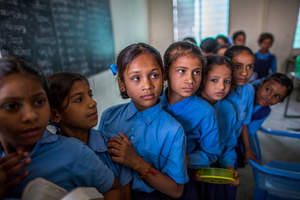NEW YORK, NY--(Marketwired - Sep 5, 2017) - As children put on their backpacks and head back to school, WaterAid takes a look at the similarities in school life across the globe as well as the stark differences and inequalities that exist in facilities and opportunities for students.
WaterAid's interviews and accompanying photo gallery highlight the fact that one in three schools have no clean water or toilets, and the detrimental impact on both students and teachers. We spoke to students in more than a dozen countries -- from Brooklyn, New York, to Burkina Faso, Canada to Cambodia -- about their experiences.
Zakir is 10 and his school in Pakistan has no access to water or toilets. "When we need the toilet, we go to the jungle," he says. "It takes 10 to 15 minutes to walk there. Our clothes and shoes get dirty, so we sometimes have to go home to change our clothes. It's not right; we should have proper toilets in our school."
Globally, one in ten children have no clean water at home, and girls in particular spend hours walking to collect water, leaving little time for education, keeping them trapped in poverty and stopping them from reaching their potential.
By contrast, access to clean water and facilities is not a concern for most American kids like 10-year-old Annabelle Woods, an incoming fifth grader at PS 295 in Brooklyn, New York.
"We have water fountains in the school and also vending machines," says Annabelle. "The toilets and bathrooms are pretty clean, and always have toilet paper. There is soap in the bathrooms. I don't think too much about the water and toilet because in the U.S., we are fortunate, where I live, to have those things."
Girls often skip school when they start their period, or drop out altogether, if there are no decent toilets or space to wash themselves. A UNESCO report estimates that one in ten girls in Sub-Saharan Africa miss school during their menstrual cycle.
"Water, sanitation and hygiene form the foundations to a healthy, prosperous life," says Sarina Prabasi, U.S. CEO of WaterAid. "One in ten children lack access to clean water while one in three have nowhere safe to go to the toilet. The lack of basic necessities exposes millions of children to deadly diseases, disrupts their education and denies them a happy, dignified childhood. WaterAid is working towards a world where all children have access to clean water and decent toilets both at home and in school, to ensure each child has the chance to realize his or her full potential."
Drinking dirty water causes sickness, which can be deadly. Nearly 290,000 children under five -- 800 children a day -- die every year due to diarrhoeal diseases caused by poor water and sanitation. Even if children recover, they still miss valuable school time. The United Nations Development Program has estimated that up to 443 million school days a year are lost due to water-related illnesses.
Download images of students worldwide: https://wateraid.assetbank-server.com/assetbank-wateraid/images/assetbox/b11e5bbe-490a-4d03-aa4a-a4b452e2bb9b/assetbox.html
Additional quotes:
Tryness Msowoya, 26, a school teacher at Kambira Primary School in Malawi, said:
"To collect water, we used to wake up around 3am. This impacted on our ability to teach well as we were tired. Also, we used to have a lot of diarrhoea cases, especially amongst our young pupils. Teachers left for another school but I told myself to stay a little longer. The first time I got a bucket of clean water from the new borehole, my life changed for the better."
Maritha, 15, from Zambia, said:
"I go to school as often as I can, but sometimes I miss it for two weeks continuously as I spend a lot of time collecting water and harvesting crops. School is important because, with education one stands a better chance of finding a job and living well in the future. If I don't stay in school, I am likely to be married off."
Sharin, 14, from Nicaragua, said:
"Before, the well at school was dirty and full of garbage, so we had to spend time walking to collect water from the well at the church. Not having water at school made it difficult to focus in class. I didn't have clean water at home so washed my clothes with water from a well. It was dirty so it would stain our clothes with a red-brownish color."
About WaterAid
WaterAid's vision is of a world where everyone has access to clean water and sanitation. The international organization works in 37 countries across Africa, Asia, Latin America and the Pacific Region to transform lives by improving access to clean water, hygiene and sanitation in some of the world's poorest communities. Since 1981, WaterAid has reached 25 million people with clean water and, since 2004, 24 million people with sanitation. For more information, visit WaterAid.org, follow @WaterAidAmerica on Twitter, or visit us at Facebook.com/WaterAidAmerica.
- Some 289,000 children die each year from diarrhoeal diseases caused by dirty water and poor sanitation. That's almost 800 children each day, or one child every two minutes.
- An estimated 844 million people (around one in ten) are without clean water
- Nearly 2.3 billion people (around one in three) live without a decent toilet
- For details on how individual countries are keeping their promises on water and sanitation, please see our online database, WASHWatch.org.
Contact Information:
For more information, please contact:
In the US:
Emily Haile
Senior Communications Manager
ehaile@wateraidamerica.org
(443) 742-2445



